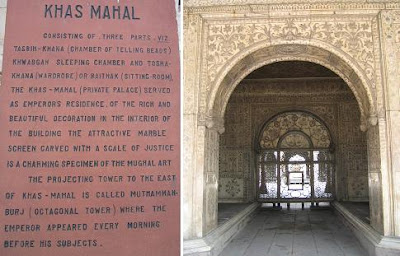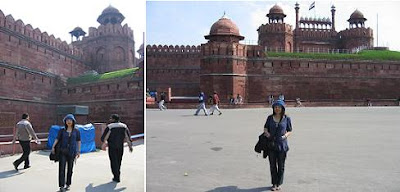I did not pay for the Camera fee of INR200. Got these 2 pictures from magazine & travel guide.
 Originally called the Masjid-i-Jahanuma, or ‘mosque commanding view of the world’.
Originally called the Masjid-i-Jahanuma, or ‘mosque commanding view of the world’.Another architectural wonder of Mughal India, the last of Shah Jahan’s great projects was completed two years before he lost his throne to his son Aurangzeb. The Jama Masjid is the largest mosque in India, one of the largest of Islam and it cost one million rupees to build.
Its striped (alternate vertical strips of red sandstone and white marble) minarets and three onion domes dominate Old Delhi. The vast open courtyard with a waer tank in the middle for washing before prayer, accommodates up to 20,000 worshippers.
1051HR Red Fort or ‘Lal Qila’
Known as Lal Qila (Red Fort) and twice the size of the Agra Fort, this mighty palace was Shah Jahan’s dream of building - ‘delightful edifices through which streams of water should flow and the terraces of which should overlook the river’.Though badly damaged in the numerous sackings of Delhi, especially by the British in 1858 when the last emperor was deposed, the fort retains some of its beauty and grandeur.
 Inside the walls, you will stroll along Chatta Chowk, a bazaar lane that used to service the courtiers with silver, jewels and brocades, and which today offers little more than predictable souvenirs.
Inside the walls, you will stroll along Chatta Chowk, a bazaar lane that used to service the courtiers with silver, jewels and brocades, and which today offers little more than predictable souvenirs. 1055HR Red Fort - Diwan-i-Am
Through the gateway is the red sandstone Hall of Public Audience, Diwan-i-Am, where the emperor sat on a raised marble throne to receive his visitors, high and low, and discuss public matters. The pavilion is decorated with pietra dura carvings of flowers, birds and a surprising scene of Orpheus with a lute, designed by a Frenchman.

Mumtaz Mahal, is obscure in origin – though it most likely housed some of the harem – and now contains the palace museum. It is worth a quick look.
Rang Mahal or Painted Palace which housed the royal harem. The emperor would retire here for his lunch to discuss housekeeping matters with his favourite daughter Jahanara, first lady since the death of his wife, Mumtaz Mahal. The Palace had a silver ceiling which has since been defaced, and a lotus-shaped marble pool with a silver fountain.
The Khas Mahal was the emperor’s private quarters, with separate apartments for prayer, eating and sleeping. He made public appearances twice a day on his octagonal balcony before a gathering of citizens down on the banks of the river. One of the rooms has an exquisite jaali (marble screen) representing the scales of justice.

Diwan-i-Khas, or Hall of Private Audience, is the political heart of the complex and aesthetically the most beautiful construction. In the centre of the bejeweled and decorated pavilion stands the Peacock Throne, pride of the emperor, entirely made of gold and inlaid with a wealth of precious stones. It was taken as loot by the Persian Nadir Shah in his bloody sacking of the capital in the 18th century. At this throne, the emperor received important visitors and reflected on matters of state. One of the arches bears an inscription composed by the famous poet Amir Khusrau: ‘If on earth there be a place of bliss, it is this, it is this, it is this.’
Moti Masjid or Pearl Mosque, built by Shah Jahan’s pious son and usurper of power Aurangzeb for his private prayers.
Behind the mosque are the lavishly carved and miraculously preserved marble royal baths or hammams.
To the far left lie two marble pavilions, the only remains of what used to be the regal, lamp-lit, richly decorated gardens of Hayat Baksh Bagh (life-giving gardens).


1252HR Raj Ghat
Wherever there is a river in India, there are ghats or river steps – for washing, fetching water, bathing, and executing cremations. Along the bank of the Yamuna, right of Mahatma Gandhi Road, there are several ghats that are also memorials to Indian politicians. Raj Ghat at the south end is where Mahatma Gandhi was cremated in 1948. there is now a moving memorial on the spot.
1344HR India Gate, Delhi’s Arc de Triomphe
An all-India war memorial commemorating the 90,000 Indian soldiers who lost their lives fighting for England in World War I. The names of more than 13,000 Indian and British soldiers killed on the northwest frontier and in the Afghan War of 1919 are inscribed on the arch. An eternal flame burns beneath it for those who died in the Indo-Pakistan War of 1971.
1423HR Lunch
1530HR Iskcon Temple
Ambassador of the spiritual world, standing tall on a Hill top. An oasis of sacredness and spirituality, it is visited by millions Indians and foreigners alike, who worship and appreciate the gorgeous deities.
1545HR Hi-Tech Sound & Light Show on Story of Lord Krishna:



1721HR Baha’i House of Worship (Lotus Temple)Shaped like a giant lotus flower and made from white Rajasthani marble, somewhat reminiscent of the Sydney Opera House in its modernist boldness. Its central hall reaches 34m.
View of Iskcon Temple from Lotus Temple

1858HR Qutab Minar
A soaring stone tower of early Muslim era, 72 metres high. Its construction began in 1193 by the first Muslim ruler of India, Qutub-ud-din Aibak. It was completed in the 13th century by his successor and son-in-law, Iltutmish, a great ruler of early Muslim India.
The tower has five distinct storeys, each with a projecting balcony. The base of the Minar (tower) is 15m in diameter and the top just 2.5m in diameter, an amazing piece of work.
Unfortunately, access to the inside staircase that leads up to the superb balconies has been closed due to suicides and accidents.At its base is the Quwwat-ul Islam Mosque, the first mosque to be built in India. A 7m high iron pillar (4th century) stands in the courtyard of the mosque.
2030HR reached Indira Gandhi Terminal 2 for
Air Sahara S2 081 DEL/SIN 15/16FEB 2230/0630
2138HR Late Dinner
2158HR After late dinner, went downstair to Gate 01, waiting for boarding
2204HR boarding
0014HR (16FEB07) late supper? early breakfast?
Aside to Garrick, Hao, Jass, Serene(MT), ...... :
...... since you said you are not likely to visit India, want me take more photo to show you, ...... hope my photo and narration meet your needs,...... change your perception, ...... and you wanna join me when I visit India again, hahaha...... ;)
By the way, ST spent not more than S$1500 for this trip.
Additional info since I've it on hand:
The Mughals
The Mughals sat on the throne of India from 1526 to 1858 but the Great Mughals ruled from 1526 to 1707. After 1707 the kings were weak and decadent. The six great Mughal monarchs were Babur, Humayun, Akbar, Jahangir, Shah Jahan and Aurangzeb. The Great Mughals were conquerors, patrons of the arts and successful administrators and their period is known in Indian history as a time of great achievement, not only in art and architecture but also in statecraft and economic management.
The Mughals had colourful romances with their queens and courtesans, they drank a lot and used excessive amounts of opium. All of them, with the exception of Aurangzeb (the last Great Mughal) were liberal and accepting of other religions.
Historical Calendar from Great Mughal Empire
1526 Babur defeats the Sultan of Delhi at the Battle of Paniput.
1526-1707 Great Mughal Empire – a golden era for arts, literature and architecture.
1612 First British trading post established in Surat by the East India Company.
1757 Battle of Plassey, the British conquer Bengal.
Early 1800s The East India Company becomes a political power in India.
1857 Sepoy Mutiny.
1858 India becomes part of the British Empire
1885 Formation of the Indian National Congress
1915 Mohandas Karamchand Gandhi arrives in India from South Africa and assumes control of the independence movement.
1947 Independence and the partition of India
1948 Gandhi is assassinated.
1949 Maharajahs agree to join 23 principalities to India, creating Rajasthan.
1950 India’s first constitution.
1964 India’s first prime minister dies.
1975 Prime Minister Indira Gandhi imposes the emergency.
1991 Free market reforms are introduced.
1999 Conflict with Pakistan over Kashmir.
2001 Severe earthquake hits Gujarat, killing 20,000 people.






















No comments:
Post a Comment